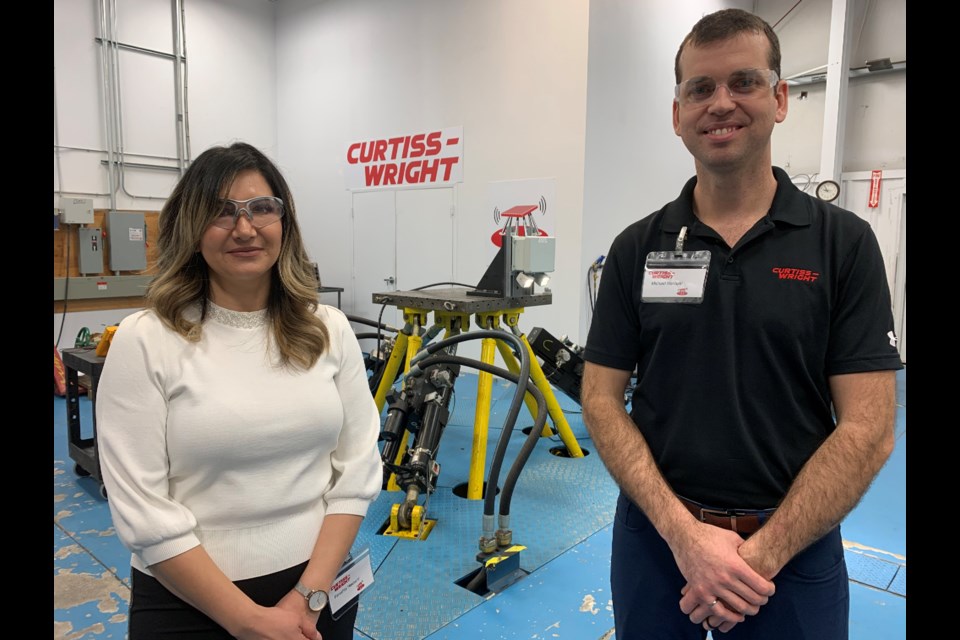Curtiss-Wright Nuclear Canada is really shaking things up in Newmarket.
You wouldn’t know it, standing outside in the barren parking lot fronting the austere industrial building on Pony Drive that houses the Canadian location of the international firm that supports the safe operation of nuclear plants throughout the world.
But inside, at the heart of the building, is a seismic “shake table” that is helping to ensure the equipment and products used in nuclear power plants like Ontario Power Generation Pickering and Bruce Power in Kincardine can withstand an earth-moving event.
The rather innocuous-looking one-by-one-meter table, with its “legs” extending deep into the ground, is actually a highly engineered instrument that performs the seismic qualification testing that has created a vast database of reports and pre-qualified items for the nuclear industry.
The tri-axial earthquake simulator tests the ability of systems and facilities to survive under realistic conditions of earthquake ground motion and other shocks and vibrations.
“Any piece of equipment that is installed into a nuclear reactor building that has a safety-related function needs to be tested to be able to perform that function, let’s say, in the event of an earthquake,” said Michael Nanowski, the principal engineer at Curtiss-Wright Nuclear Canada who oversees seismic and commercial grade dedication.
Curtiss-Wright Nuclear Canada provides project management, equipment qualifications and commercial grade dedication to the Canadian nuclear market and international fleet of CANDU utilities.
Services include seismic testing and analysis, radiation testing, LOCA simulation, thermal aging, and safety-related repair, refurbishment and reverse engineering to extend the life of electrical and mechanical components.
Curtiss-Wright is currently working with a team of the Ontario Tech University graduate engineering students and their professor to deepen their knowledge of the seismic table’s behaviour, thanks to a $25,000 grant from the Natural Sciences and Engineering Research Council of Canada (NSERC), said engineer Fareshta Hashemi, a Curtiss-Wright project manager.
NSERC is the biggest funder of scientific projects in Canada.
“We’re excited to dive into this research project that will allow us to better understand our seismic table,” said Nanowski at an event last week launching the project. “But we’re also excited about the growing partnership with (Ontario Tech) and Curtiss-Wright.”
The firm currently has an Ontario Tech student working on an eight-month program to support the engineering and quality assurance teams, he said.
A demonstration in the seismic lab of an SSE (safe shutdown event) — “the coolest test”, according to engineer Charlie Cook — was held for the students.
An emergency light was placed on the table for the test, which was observed behind a glass wall, with safety glasses also required.
Equipment weighing up to 10,000 pounds, up to acceleration levels of 80g, can be tested on the shake table, said engineer Raymond Ng.
The emergency lights, which would be installed at OPG on poles and walls, would activate if the power fails, Ng said, and the test will ensure that before, during and after a shake that the equipment is functioning safely, Ng said.
The test, which usually includes multi-frequency "tussles" and "side sweeps”, also takes into account the aging of equipment.
“A reactor is projected at 40 years of service before it’s refurbished or recommissioned, and each test sample needs to be aged as such,” explained Cook. “So, if it’s in a harsh environment, let’s say a high-temperature environment because there are a lot of hot areas in the reactor building, then we’ll do a thermal aging test.
“We would put this entire assembly into an oven and age it at an elevated temperature to simulate 40 years of that elevated temperature.”
Aging due to radiation and vibration aging is also tested, depending on where the equipment is to be installed and its safety function.
In this case, because the lighting was to be installed on high poles and walls, elevation and building amplification were factored into the test.
A hydraulic pump is turned on, the table raises and begins to shake for about 30 seconds.
A graph visible on a computer monitor plots the results.
The equipment “passes” the test, as the lights came on during the simulated power outage, and stayed on, without flickering.
The student research team had a barrage of questions and suggestions for the engineers following the demonstration, which is “fantastic”, Nanowski said.
“It is our belief that more of these partnerships need to be generated between the industry and the educational institutions so that graduates have a better understanding and appreciation of how to prepare themselves for the workforce and to become a more attractive candidate when they graduate,” he said.
Dr. Atef Mohany, an associate professor in the faculty of engineering and applied Science/department of automotive, mechanical and manufacturing engineering, will be overseeing the research project, and “hopefully he will gain more in-depth understanding of the industry requirements and will be able to gear the educational content to best practices in the industry, so their students may gain a sought-after knowledge base that the industry partners are looking for,” Nanowski added.
Curtiss-Wright Nuclear Canada, which opened its Newmarket location through an acquisition, is one arm of the global Curtiss-Wright Corporation that delivers products and services to the commercial, industrial, defence and energy markets, said Renate Naghavi, a customer service representative for the engineering firm in Newmarket.
Seismic qualification testing is also performed at the Curtiss-Wright Nuclear facilities in Cincinnati, Ohio.
The company, which employs about 9,000 people worldwide, can trace its roots back to founders Glenn Curtiss, father of naval aviation, and the Wright brothers, renowned for history's first flight, in 1929 in the United States.



